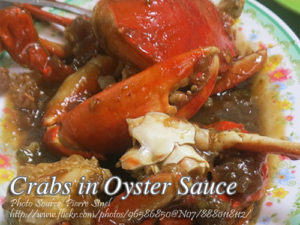Oysters is one of the favorite seafood among Pinoys but because it is high in cholesterol and expensive, not many are enjoying this delicious shellfish. Most of the time oysters are best eaten half cooked or blanched. Some eat it raw but because there are still live organism that may be present inside the oysters, it is best to cooked it first before eating. No one can be sure if the place where the fishermen caught it is clean even if they are cultured.
This adobong talaba is a very simple adobo dish using shellfish like an oyster. Not only it is easy, the time you need to cook it will only last for a few minutes because you can’t overcook an oyster. Because it will become very tough and it will shrink too much if you overcook it.
A Flavorful Twist on Adobo
Indulging in the rich flavors of seafood is a quintessential part of Filipino cuisine. Among the array of ocean delights, oysters hold a special place in the hearts of many Pinoys. However, due to their high cholesterol content and relatively higher cost, they are often considered a luxury. Despite this, oysters remain a beloved treat, best enjoyed either half-cooked or blanched. Some even relish them raw, although caution is advised due to the potential presence of live organisms inside. This uncertainty underscores the importance of cooking oysters thoroughly, especially since their origin and cleanliness cannot always be guaranteed.
A Quick and Easy Delight
Oysters Adobo presents a simple yet delightful way to enjoy this prized shellfish. This dish not only offers a straightforward cooking process but also boasts a remarkably short cooking time. Oysters cook quickly, and overcooking should be avoided at all costs, as they can become tough and shrink significantly.
Cooking up a Flavorful Adobong Talaba
- Sautéing the Aromatics: Begin by heating cooking oil in a skillet. Sauté garlic until it turns slightly brown, then add onions and continue sautéing until they turn soft.
- Seasoning with Salt and Pepper: Add a pinch of salt and pepper, stirring for a few seconds to incorporate the flavors.
- Adding the Oysters: Introduce the star of the dish – the oysters. Stir them in with the garlic and onions, ensuring they are well-coated in the flavors.
- Infusing with Soy Sauce, Vinegar, and Bay Leaf: Pour in the soy sauce and vinegar, and add a bay leaf for that distinctive adobo aroma. Mix everything well.
- Simmering to Perfection: Cover the skillet and let the mixture simmer for about a minute. This allows the flavors to meld and infuse into the oysters.
- Intensifying the Flavors: After a minute, remove the oysters from the skillet and set them aside. Continue simmering the remaining liquid in the pan for an additional 2 to 3 minutes, or until it has reduced by half.
- Bringing It All Together: Return the oysters to the skillet and let them simmer in the reduced sauce for another minute.
- Serving Up: Serve your oysters hot, garnished with chopped green onions for an added burst of freshness.
Food for Thought: The History of Adobo
Adobo, the cooking method that gives rise to oysters adobo, is a culinary legacy deeply rooted in Philippine history. The term “adobo” is derived from the Spanish word “adobar,” meaning “to marinate” or “to pickle.” This cooking style was introduced to the Philippines by Spanish colonizers during the 16th century. Initially used as a method of preserving meat, adobo has evolved into a beloved Filipino dish known for its rich, savory flavors.
The dish stands as a testament to the adaptability and creativity of Filipino cuisine. By combining the traditional adobo method with the unique flavors of oysters, this dish showcases the rich diversity of flavors found in Philippine culinary traditions.
Wrap-Up
Adobong talaba offers a tantalizing twist on a classic Filipino dish. Its simple yet flavorful preparation makes it a perfect choice for seafood lovers looking to enjoy the rich taste of oysters. Whether enjoyed as a main dish or as a delightful appetizer, it is sure to delight your taste buds with its unique blend of flavors.
How to Cook Adobong Talaba (Oysters Adobo)
Ingredients
- 1/2 kilo oysters shucked, cleaned and drained
- 2 Tbsp. soy sauce
- 2 Tbsp. vinegar
- 3 cloves minced garlic
- 1 pc onion chopped
- 1/2 tsp. ground black pepper
- 2 pcs bayleaf
- 1/8 cup water
- 1 Tbsp. cooking oil
Instructions
How to Cook Adobong Talaba
- In a skillet, heat cooking oil and saute garlic until slightly brown then add onion and saute until soft.
- Then add salt and pepper. Mix for a few seconds than add the oysters. Stir cook for a few seconds until the garlic and onions are mixed with the oysters.
- Add the soy sauce, vinegar, bay leaf and water. Cover and simmer for 1 minute.
- Stir cook for a few seconds and turn off heat. Separate the oysters in a bowl and leave the rest on the ingredients in the pan.
- Simmer again for 2 to 3 minutes until the liquid has evaporated to half. Then put the oysters back in the pan.
- Simmer again for 1 minute and serve hot.
Notes
Cooking Tips:
- Select oysters with firmly sealed shells, indicating freshness. Discard those with open shells, signaling potential contamination. Oysters must be alive when prepared.
- Under cold running water, scrub each oyster shell meticulously. Utilize a brush to eliminate any residue, paying close attention to the hinge area where debris often accumulates.
- Oysters require minimal cooking time to retain their delicate texture. Add them to the heated sauce during the final moments, simmering briefly for one to two minutes. Overcooking will result in a tough, unpalatable texture, so exercise caution.






Very informative